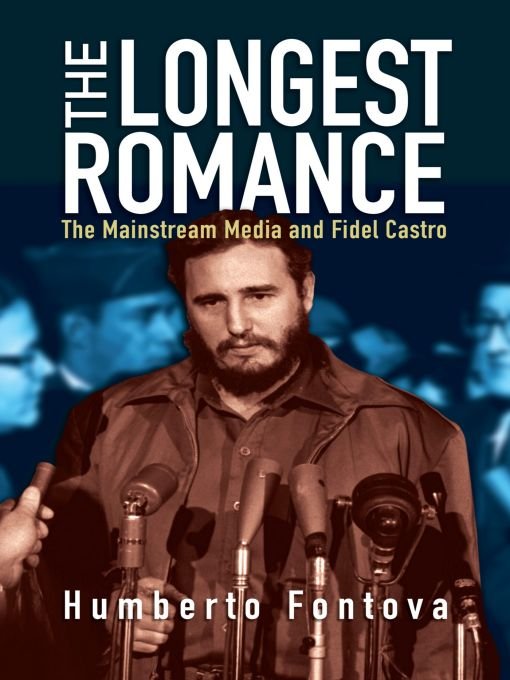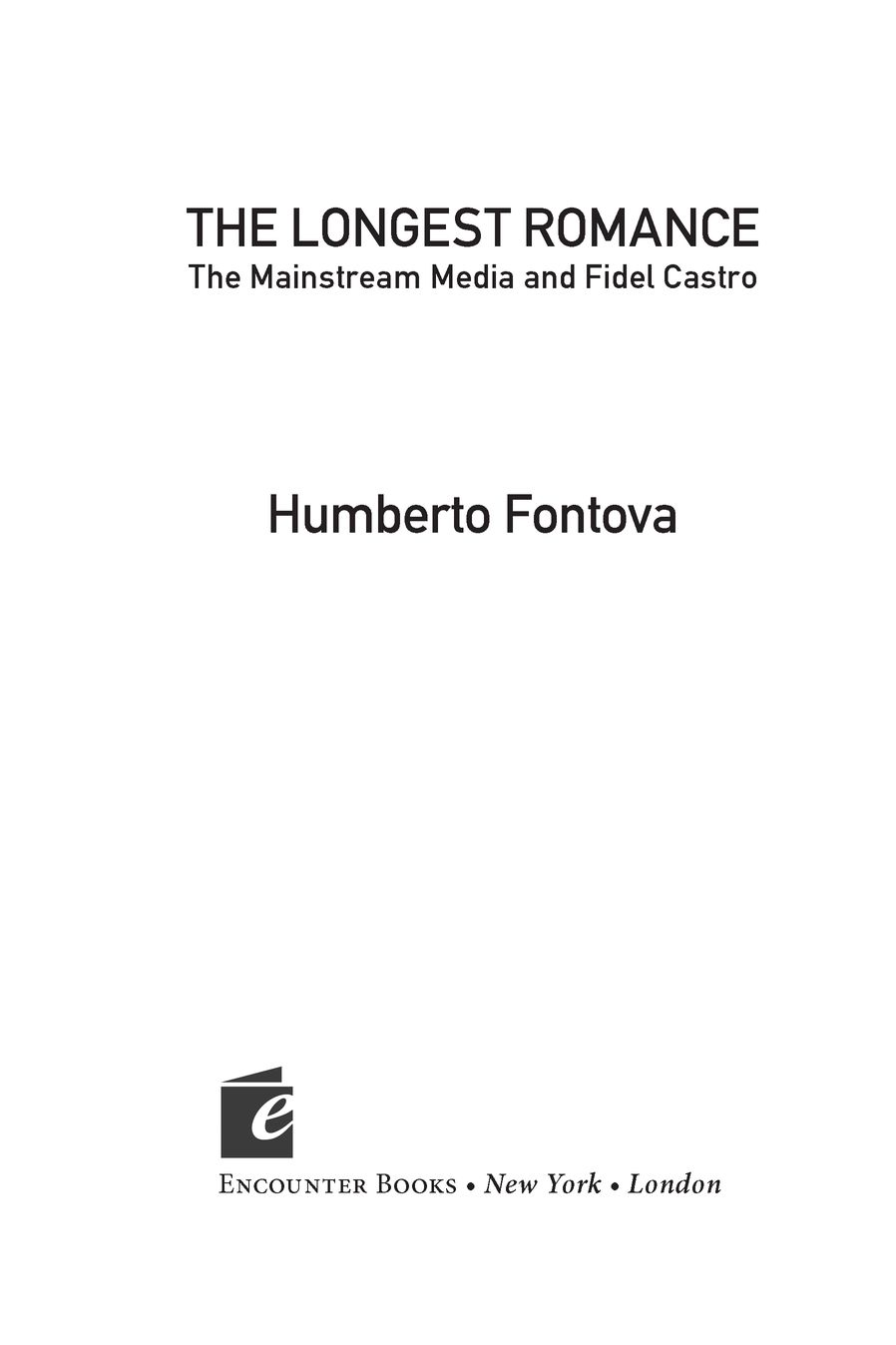The Longest Romance
Read The Longest Romance Online
Authors: Humberto Fontova



Table of Contents
Â
Â
Â
Â
Â
Â
Â
Â
Â
Â
Â
Â
Â
Â
Â
Â
Â
Â
Â
Â
PREFACE
The Connections You Don't See
H
e jailed political prisoners at a rate higher than Stalin during the Great Terror. He murdered more Cubans in his first three years in power than Hitler murdered Germans during his first six. He came closer than anyone in history to starting a worldwide nuclear war. In the above process Fidel Castro converted a nation with a higher per-capita income than half of Europe and a huge influx of immigrants into one that repels the poorest people in the region and boasts the highest suicide rate in the Western Hemisphere.
e jailed political prisoners at a rate higher than Stalin during the Great Terror. He murdered more Cubans in his first three years in power than Hitler murdered Germans during his first six. He came closer than anyone in history to starting a worldwide nuclear war. In the above process Fidel Castro converted a nation with a higher per-capita income than half of Europe and a huge influx of immigrants into one that repels the poorest people in the region and boasts the highest suicide rate in the Western Hemisphere.
Who would guess any of this from reading the mainstream media? Instead we read almost exclusively about how Castro freed Cuba from the greedy clutches of U.S. robber barons and mobsters and rewarded his downtrodden countrymen with free health-care and education. A scornful Uncle Sam then retaliated with a vindictive embargo, still in place. Topping off a half-century of tortured history,
Newsweek
hailed Cuba as among “the best countries in the world to live.”
Newsweek
hailed Cuba as among “the best countries in the world to live.”
In July 1958 an excited American magazine reporter climbing his way up to Castro's guerrilla hideout in Cuba's mountains for a supposedly exclusive interview with the elusive guerrilla chief stopped and gaped at another reporter passing him on the way down. The reporter coming downhill, clutching a secret interview of his own, worked for
Boys'Life
magazine, the official publication of the Boy Scouts of America.
1
Boys'Life
magazine, the official publication of the Boy Scouts of America.
1
Farther along the curiously well-trod trail, the reporter stopped and gaped again. Straight ahead was a huge sign reading “Press HutâThis Way.” Castro had recently installed it to accommodate the throng of journalists seeking interviews at his “secret camp.” By then reporters from
The New York Times
to CBS, from
Look
and
Life
to
Reader's Digest
and
Boys'Life,
had all managed the terrifying trek to the remote hideout while evading Batista's brutal army and police and obtaining exclusive interviews with the furtive guerrilla commander.
The New York Times
to CBS, from
Look
and
Life
to
Reader's Digest
and
Boys'Life,
had all managed the terrifying trek to the remote hideout while evading Batista's brutal army and police and obtaining exclusive interviews with the furtive guerrilla commander.
Two years later, in his
Reminiscences of the Cuban Revolutionary War
, Che Guevara snickered: “Foreign reportersâpreferably Americanâwere much more valuable to us than any military victory. Much more valuable than recruits for our guerrilla force were American media recruits to export our propaganda.”
Reminiscences of the Cuban Revolutionary War
, Che Guevara snickered: “Foreign reportersâpreferably Americanâwere much more valuable to us than any military victory. Much more valuable than recruits for our guerrilla force were American media recruits to export our propaganda.”
Five years earlier, in a letter to revolutionary colleague Melba Hernandez, Fidel Castro had laid down his movement's mission statement: “We cannot for a second abandon propaganda. Propaganda is vitalâpropaganda is the heart of our struggle. For nowwe use a lot of sleight of hand and smiles with everybody. There will be plenty of time later to crush all the cockroaches together.”
2
2
After so many fake smiles and crushed cockroaches, you'd hope journalists would be on their guard when accepting Castro-regime press releases. But history records few media recruitment drives as phenomenally successful or as enduring as Castro and Che's.
“Cuban mothers, let me assure you that I will solve all Cuba's problems without spilling a drop of blood.” Upon entering Havana on January 8, 1959, Cuba's new leader Fidel Castro broadcast that promise into a phalanx of microphones. “Cuban mothers,” he continued as the jubilant crowd erupted with joy, “let me assure you that because of me you will never have to cry.”
3
3
The following day, just below San Juan Hill in eastern Cuba, a bulldozer rumbled to a start, clanked into position and pushed dirt into a huge pit with blood pooling at the bottom from the still-twitching bodies of more than a hundred men and boys who'd been
machine-gunned without trial on orders of the Castro brothers, as many wives and mothers wept hysterically from a nearby road.
machine-gunned without trial on orders of the Castro brothers, as many wives and mothers wept hysterically from a nearby road.
On that very day the prestigious
Observer
ran the following: “Mr. Castro's bearded, youthful figure has become a symbol of Latin America's rejection of brutality and lying. Every sign is that he will reject personal rule and violence.”
Observer
ran the following: “Mr. Castro's bearded, youthful figure has become a symbol of Latin America's rejection of brutality and lying. Every sign is that he will reject personal rule and violence.”
These two events epitomize the Castro phenomenon, even half a century later. The Cuban regime oppresses and murders while issuing a smokescreen of lies not merely devious but positively psychopathic. The international media abandon all pretense to be investigators or watchdogs (or even reporters); they become not merely sycophants but publicists.
On April 21, 1959, Fidel Castro said to Americans: “I am not a communist for three reasons: communism is a dictatorship and for my entire life I have been against dictatorships. Furthermore, communism means hatred and class struggle, and I am completely against such a philosophy. And finally because communism opposes God and the Church. I say this to set your minds and spirits at rest.”
4
4
For three months prior to that date, Fidel Castro and his Stalinist partners, Raul Castro and Che Guevara, had already been hosting Soviet GRU agents in their respective stolen mansions and buttoning down the Stalinization of Cuba. Fidel's brother Raul and sister-in-law Vilma Espin had had assigned KGB handlers since 1953.
5
5
A half-century of relentless Castroite Communism later, one could have hoped that mainstream journalists would adopt a more prudent approach in reacting to this regime's statements.
This book will show how utterly vain is that hope.
The media's heraldry of Fidel Castro in 1957 or 1939âthough often based on reflexive anti-Americanism, laziness, stupidity and condescension towards Latins (maybe a taste of the lash is what those volatile and frivolous people need)âwas in some ways excusable. “A man of many ideals, including those of liberty, democracy,
and social justice,” gushed
The New York Times
about Castro in February 1957. Many prominent Cubans, after all, were equally deluded. But the same theme over half a century later can only be described as the journalistic version of battered-wife syndrome. Among historical figures, Fidel Castro wins hands down as the most persistently effective liar of modern times.
and social justice,” gushed
The New York Times
about Castro in February 1957. Many prominent Cubans, after all, were equally deluded. But the same theme over half a century later can only be described as the journalistic version of battered-wife syndrome. Among historical figures, Fidel Castro wins hands down as the most persistently effective liar of modern times.
“Castro's use of propaganda-assetsâinterviews with journalists, radio broadcastsâduring his guerrilla war against Batista contributed in a major way to his victory and was a preview of the methods he would use so successfully after coming to power,” states a declassified CIA document from 1984 titled “Castro's Propaganda Apparatus.” “Immediately after assuming power,” it continues, “Fidel Castro set out creating a propaganda empire that today is perhaps the most effective in the Western Hemisphere.”
Sadly, the CIA itself is a victim of Castro's effectiveness. In 1987, Cuban intelligence officer Florentino Aspillaga defected in Prague and revealed that every Cuban agent (four dozen of them) the CIA had recruited to spy on the Castro regime since 1962 was a double agent controlled personally by Fidel Castro.
6
6
But according to Norman Bailey, formerly of the U.S. office of the Director of National Intelligence: “For Castro, being able to influence U.S. policy and elite opinion-makers is even more important than recruiting spies with access to intelligence information.”
7
Foremost among his successes is Castro's penetration of U.S. media.
7
Foremost among his successes is Castro's penetration of U.S. media.
For close to a decade, most of what Americans have read about Cuba has been doctored by Castro-regime “agents of influence” working in concert with the regime's intelligence service. Let's hope the CIA has finally caught on. “Useful idiocy” is one thing, deliberate collaboration quite another. We'll introduce you to the folks in both camps.
In 1984, KGB defector Yuri Bezmenov wrote: “Cynical, egocentric people who can look into your eyes with angelic expression and tell you a lieâthese are the most recruitable people for us;
people who lack moral principlesâwho are either too greedy or who suffer from exaggerated self-importance. These are the people the KGB wants and finds easiest to recruit.”
8
people who lack moral principlesâwho are either too greedy or who suffer from exaggerated self-importance. These are the people the KGB wants and finds easiest to recruit.”
8
As if nothing in the intervening half-century had called into question the veracity of Castro regime press releases, on August 8, 2009 a CNN “Special Report” on Cuba's health-care gushed about the island nation's “impressive health statistics.” The show featured clips from Michael Moore's so-called documentary
Sicko
, while CNN's Morgan Neill, on location at a for-show Havana hospital, reported live. “Cuba's infant-mortality rates are the lowest in the hemisphere,” he recited, “in line with those of Canada! Cuba can boast about health-care, a system that leads the way in Latin America.”
Sicko
, while CNN's Morgan Neill, on location at a for-show Havana hospital, reported live. “Cuba's infant-mortality rates are the lowest in the hemisphere,” he recited, “in line with those of Canada! Cuba can boast about health-care, a system that leads the way in Latin America.”
Other books
The Rancher's Dance by Allison Leigh
Sugar Cube by Kir Jensen
Tras la máscara del Coyote / El Diablo en Los Angeles by José Mallorquí
The Sadist's Bible by Nicole Cushing
Star Island by Carl Hiaasen
Aurora 06 - A Fool And His Honey by Charlaine Harris
The Taste of Conquest by Krondl, Michael
The Testimony of Taliesin Jones by Brook, Rhidian
